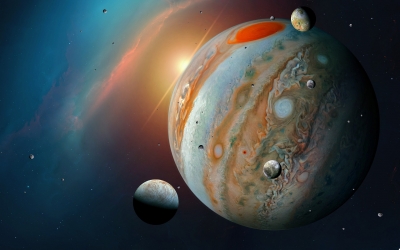
The largest planet in the solar system, the gas giant Jupiter is approximately 318 times as massive as Earth. If the mass of all of the other planets in the solar system were combined into one “super planet,” Jupiter would still be two and a half times as large.
Jupiter has a mean radius of 43,440.7 miles (69,911 kilometers), about a tenth that of the sun. However, its rapid rotation — it spins once every 9.8 hours — causes it to bulge at the equator, where the diameter is 88,846 miles (142,984 km). In contrast, the diameter at the poles is only 83,082 miles (133,708 km). This stretched shape is known as an oblate spheroid.
If you were to walk around the equator of Jupiter, you would travel 272,946 miles (439,264 km), over 10 times the distance around Earth’s center line.
Because Jupiter is made of gas, mostly, its surface is considered uniform. As such, it lacks high and low points — mountains and valleys — such as those found on rocky terrestrial planets.
Credit : Space.com
Picture Credit : Google




